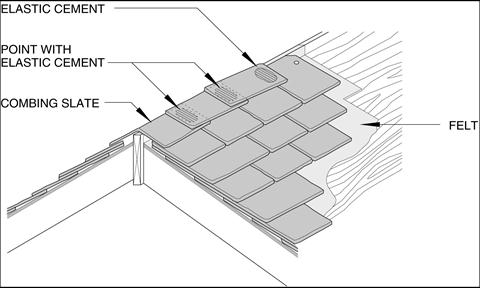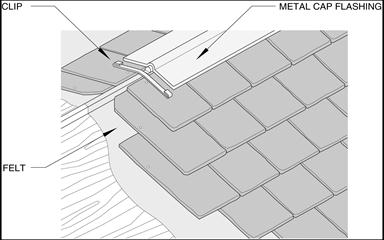Difference between revisions of "TS Details:E4.7.10 (Slate - Ridges)"
Difference between revisions of "TS Details:E4.7.10 (Slate - Ridges)"
(Created page with "<hr> Ridges have several traditional styles including saddled or a metal flashing. Ridges are installed after the field slates are installed flush with each other on opposite...") |
|||
| Line 1: | Line 1: | ||
| − | < | + | <div class="panel panel-success"> |
| + | <div class="panel-heading"><big>'''Slate Roofing Details'''</big></div> | ||
| + | <div class="panel-body"> | ||
| + | <div class="col-md-6"> | ||
| + | <div style="text-align:center; vertical-align:center"> | ||
| + | [[File:7.4.1.2.8.jpg|class=img-responsive]] | ||
| + | |||
| + | [[File:7.4.1.2.9.jpg|class=img-responsive]] | ||
| + | </div> | ||
| + | </div><!-- COL-MD-6 --> | ||
| + | |||
| + | <div class="col-md-6"> | ||
| + | |||
Ridges have several traditional styles including saddled or a metal flashing. Ridges are installed after the field slates are installed flush with each other on opposite sides of the ridge. | Ridges have several traditional styles including saddled or a metal flashing. Ridges are installed after the field slates are installed flush with each other on opposite sides of the ridge. | ||
* Saddle Ridges | * Saddle Ridges | ||
:The slates are run horizontally and overlapping with the nails being driven between slates of the last course. Elastic cement should be applied in overlaps and joints on top of the ridge. | :The slates are run horizontally and overlapping with the nails being driven between slates of the last course. Elastic cement should be applied in overlaps and joints on top of the ridge. | ||
| − | |||
| − | |||
* Metal Ridge Cap | * Metal Ridge Cap | ||
:Metal used for a ridge cap should be non-corrosive to last the life of a slate roof. It is installed on a ridge board and must cover the last course of slate down to its normal exposure. Attachment is provided by hidden clips. | :Metal used for a ridge cap should be non-corrosive to last the life of a slate roof. It is installed on a ridge board and must cover the last course of slate down to its normal exposure. Attachment is provided by hidden clips. | ||
| + | </div><!-- COL-6-MD --> | ||
| + | </div><!-- PANEL BODY --> | ||
| + | </div><!-- PANEL --> | ||
| + | |||
| − | |||
<hr> | <hr> | ||
| Line 16: | Line 29: | ||
| − | [[Section:E. Application: Steep Slope Roofs|<i class="fa fa-chevron-circle-left fa | + | [[Section:E. Application: Steep Slope Roofs|<i class="fa fa-chevron-circle-left fa" ></i> Back to ''Slate Application'']] |
| − | [[Tile and Slate Construction Details|<i class="fa fa-chevron-circle-left fa | + | [[Tile and Slate Construction Details|<i class="fa fa-chevron-circle-left fa" ></i> Back to ''Tile and Slate Construction Details'']] |
| − | [[Section:G. Construction Details|<i class="fa fa-chevron-circle-left fa | + | [[Section:G. Construction Details|<i class="fa fa-chevron-circle-left fa" ></i> Back to ''Construction Details'']] |
Revision as of 21:22, 19 August 2016
Slate Roofing Details
Ridges have several traditional styles including saddled or a metal flashing. Ridges are installed after the field slates are installed flush with each other on opposite sides of the ridge.
- Saddle Ridges
- The slates are run horizontally and overlapping with the nails being driven between slates of the last course. Elastic cement should be applied in overlaps and joints on top of the ridge.
- Metal Ridge Cap
- Metal used for a ridge cap should be non-corrosive to last the life of a slate roof. It is installed on a ridge board and must cover the last course of slate down to its normal exposure. Attachment is provided by hidden clips.


